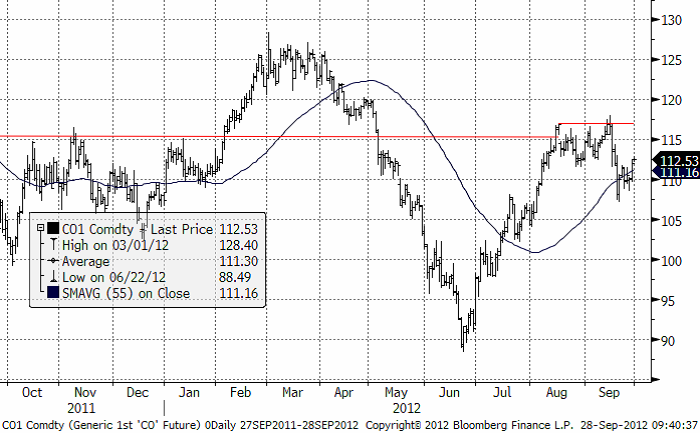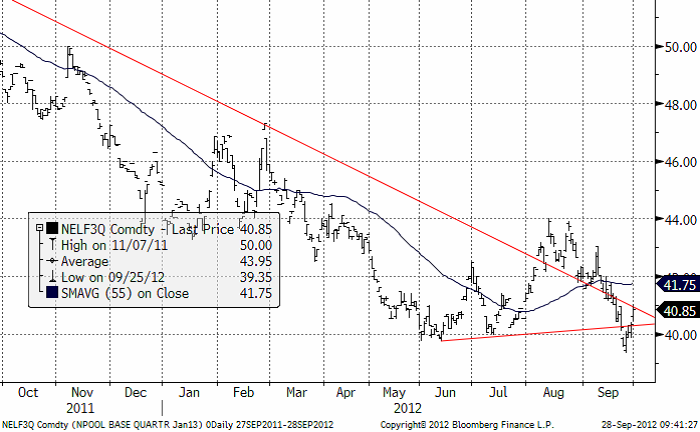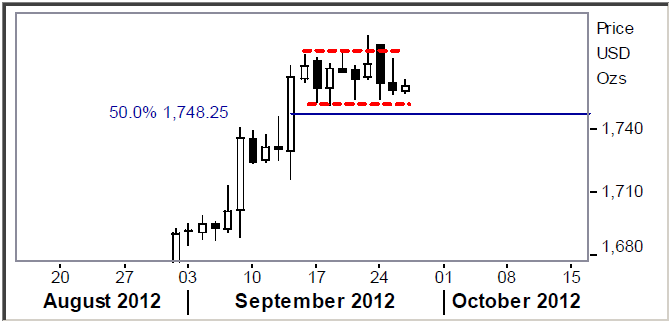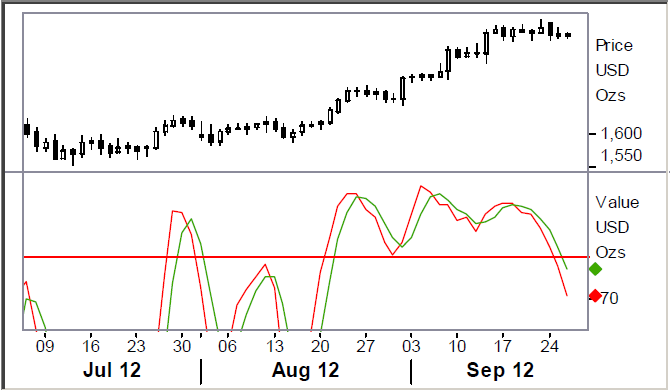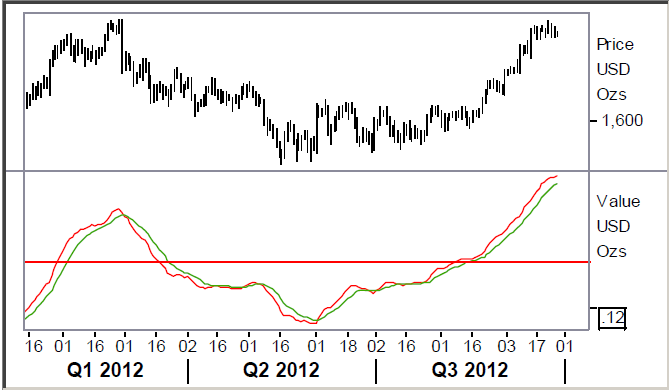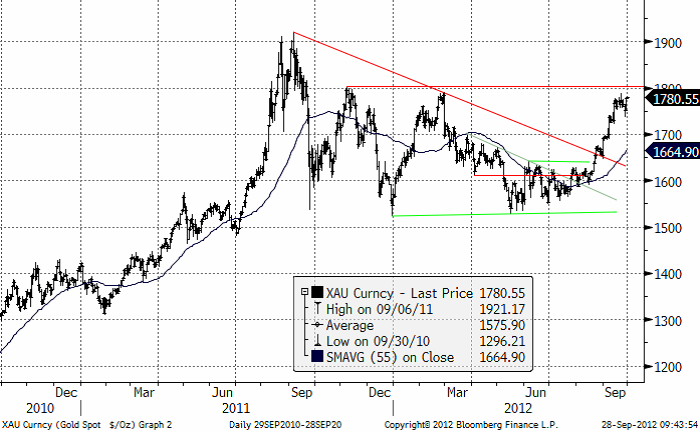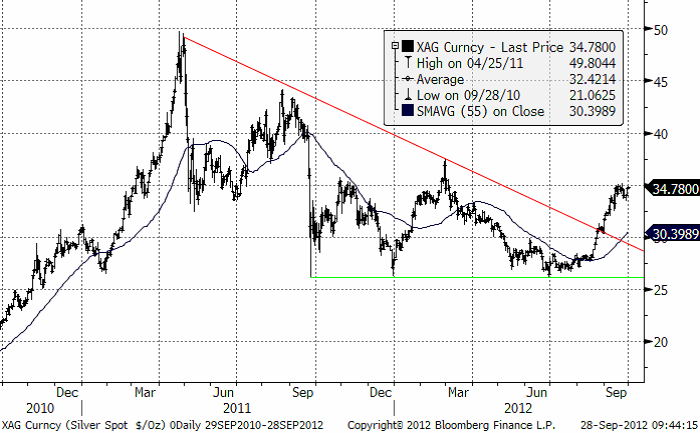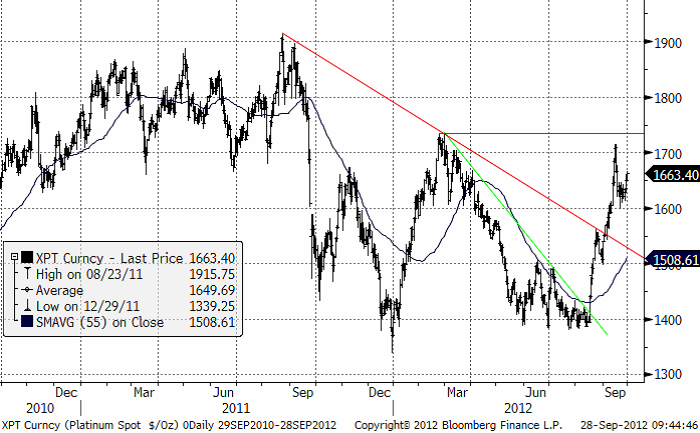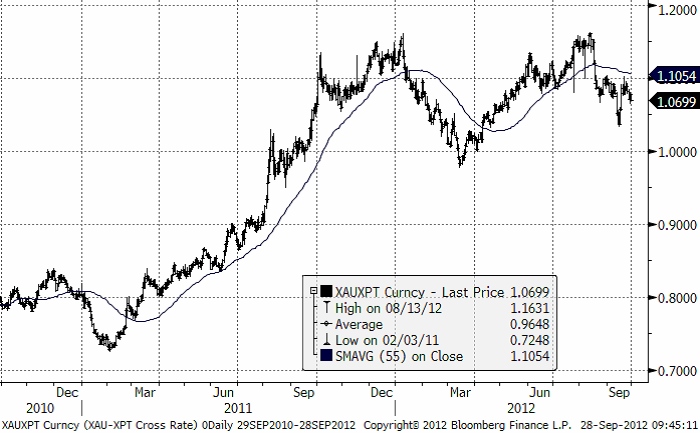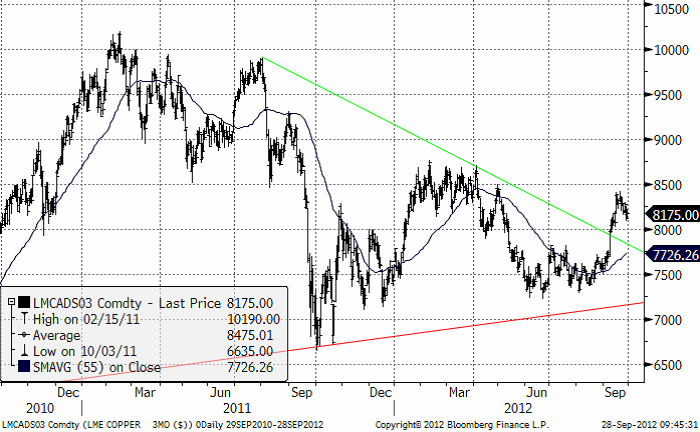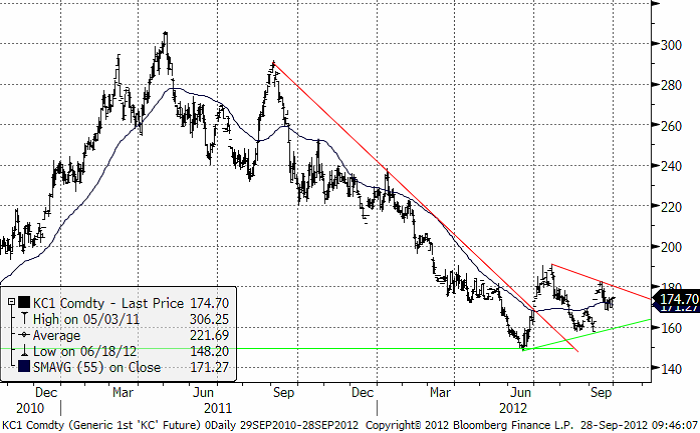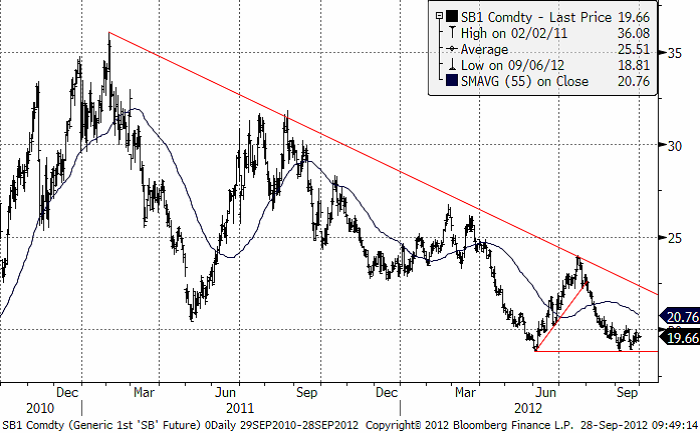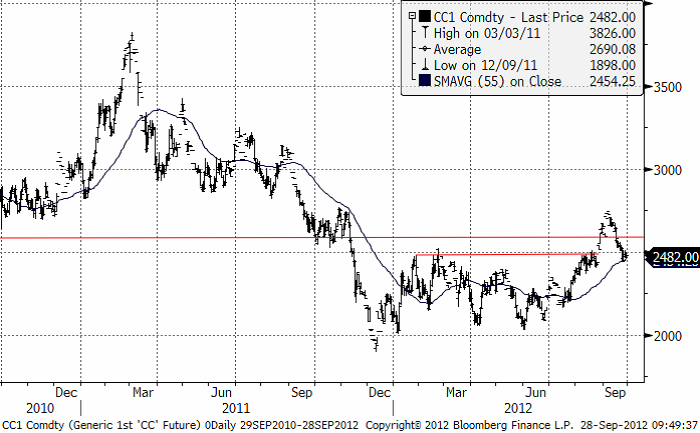Analys
SEB – Råvarukommentarer, 28 september 2012
Sammanfattning av rekommendationer
Summan av resultatet blev vinst på 12%, efter förra veckans förlust på -1%.
Viktigast den här veckan är att vi tror att det kan komma en rekyl i guldpriset. Det ser ut så rent tekniskt. Priset har rusat iväg väldigt fort och är uppe på nivåer där det sannolikt finns många som vill ta hem vinster. Vi ser detta som en teknisk och kortsiktig rekyl. Vi anser att det finns gott om värde i Platina och väljer att ligga kvar köpta den, samtidigt som vi mycket kortsiktigt rekommenderar en kort position i guld. Råolja går vi över till neutral rekommendation på, liksom på silver, som ligger någonstans mellan guld och platina i vår vy nu.
Jordbruksprodukterna är vi neutrala till negativa till. Det kommer viktig lagerstatistik från USDA senare idag, som är värt att hålla koll på. Kaffe, socker och kakao ligger alla lågt i pris, och tycks bilda bottenformationer inför en eventuell trendvändning. För närvarande är vi neutrala.
Råolja – Brent
Det blev ingen omedelbar prisuppgång i Brentolja efter USAs tredje omgång av kvantitativa lättnader. Brentoljan faktiskt har fallit snarare än motsatsen. Den främsta orsaken till detta är på den ökande oron över situationen i Europa vilket resulterar i en starkare USD och en svagare euro. Medan Mellanösterns försörjningsavbrott och olösta situationen håller oljepriset sig högt men den grundläggande makrobilden ser svag ut och drar i baisseriktning. Vi har en neutral syn på Brentolja för närvarande till ett pris av $ 110 / b. Saudiarabien skulle gärna se att oljepriset blev lägre i syfte att lindra den globala makrosituationen men har inte lyckats hittills. Saudiarabien fortsätter dock att försöka hålla ner oljepriset genom att hålla sin oljeproduktion på en förhöjd nivå.
I nuläget förhåller vi oss neutral men ser nivåer kring 105 USD som en mycket attraktiv nivå för en lång position.
Elektricitet
Elmarknaden föll genom stödet, men vände sedan upp igen och ligger nu precis under motståndet. Den kortsiktiga trenden är nedåtriktad och vi ser uppgången som en rekyl. Ser vi till marknaden för kol, vars pris helt och hållet styr priset på el i Norden, är den marknaden i en tydlig nedåttrend sedan en topp i början på augusti. Däremot är priset på kol nere på en nivå, där priset funnit stöd flera gånger förut, i maj, juni och juli. Marknaden testar alltså historiska bottennivåer i såväl kol som el. Vi har ännu inte en köprekommendation, utan behåller neutral rekommendation.
Vidare kan nämnas att väderleksrapporten visar riklig nederbörd, reservoarerna är på 5-årshögsta och hydrobalansen är 12 till 15 TWh över det normala. Nordiska kärnkraftverk väntas vara helt online från den 26 oktober och global ekonomisk aktivitet minskar såväl i Asien som i Europa och är svag och oförutsägbar i USA. Detta gör att vi är oroliga för ytterligare nedsida i elpriset. Icke desto mindre, handlas kontraktet för det första kvartalets genomsnittliga spotpris för 2013, som är underliggande för våra ETN:er, nära 40 euro per MWh, som vi anser är ett bra pris inför vintern. Första kvartalet är trots allt det kallaste kvartalet. Det finns möjligheter till kortsiktiga uppgångar till 44 euro.
Guld och Silver
Efter den initiala reaktionen efter FED har guld och silver inte orkat klättra vidare. Många aktörer som köpt på förväntningar om ytterligare stimulanser har legat beredda att ta hem vinster. Det gamla ordspråket ”buy the rumour and sell the fact” verkar gälla även den här veckan. Undertonen är ändå stark och rekylerna endast marginella. Vi bedömer att priserna har fortsatt mer att ge med nivån $1800 inom räckhåll för guld (spot i London handlas kring $1862 i skrivandes stund). En tänkbar strategi (för den som inte redan köpt) är att bevaka den tidigare högsta nivån $1780 och agera på ett genombrott. Scenariot är likartat för silver med rekommenderad bevakning av förra veckans toppnivå på $35/oz ($34,50 i skrivandes stund). Vår tekniska analys indikerar en större rekyl på nedsidan om nivån 1748 bryts på stängningsbasis. Se våra tekniska kommentarer nedan:
Bankens tekniska analytiker menar så här: “Last Friday printed an up-thrust top, a false break higher. The move was on Monday followed by a gap higher and an immediate reversal creating a bearish engulfing/key day reversal candle. A break below 1752 will confirm at least a short term top formation (and more so breaking below the mid body pt, 1748, of the latest rising benchmark candle).” Dessutom ser man en divergens mellan den tekniska indikatorn stochastics, som ofta används som en överköpt/översåldindikator:
“There is a confirmed bear divergence between price and stochastic i.e. a higher top in price and a lower one in the indicator”. Vi ser en bild på detta nedan:
En annan teknisk indikator, MACD, visar på en överköpt marknad, som vi ser i nedanstående diagram, samtidigt som priset på guld ligger väldigt nära toppnivåerna från det första kvartalet.
Nedan ser vi lite längre historik för guld i dollar per troy ounce.
Nedan ser vi kursdiagrammet för silver i dollar per troy ounce, som ligger precis under 35 dollar. Vi har sett att det verkar finnas säljare på 35 dollar.
Platina
Trots strejkslutet vid Lonmins gruva i Sydafrika vände marknaden uppåt i veckan. Spotnoteringen i London är upp ca 1,5 % sen förra fredagen. Lonmin har finansiella problem och strejkvågen riskerar att sprida sig till andra platinagruvor. Flera guldgruvor har produktionsstopp p.g.a. nya strejker. Risken är stor för minskat utbud från regionen. Den industriella efterfrågan är relativt svag i Europa men fordonsindustrin i Kina förväntas skapa god tillväxt. Vi kvarstår med köprekommendationen.
Nedan ser vi priset på guld dividerat med priset på platina. Vi ser att guld har utvecklats sämre än platina sedan mitten avaugusti. Tekniskt ser den här trenden stark ut och har potential att gå från 1.05 till 1, dvs en outperformance på ytterligare 7%till platinas fördel. Som vi ser av den längre historiken brukar platina vara betydligt dyrare än guld. Dagens rabatt på platina iförhållande till guld är väldigt ovanlig.
Koppar
Prisutvecklingen har varit lite ”tråkig” för basmetallerna under veckan. Fokus har återigen skiftat tillbaka till Europa. Preliminära PMI- siffror från Eurozonen kom in lägre än väntat, 45,9 mot 46,3 förra månaden. IFO-Index (företagsklimatet) från Tyskland ingav inte heller något ökat förtroende. Ingen viktig statistik från Kina, men marknaden känner sig tveksam till aktiviteten där just nu. Det är egentligen bara US som faktiskt visar positiva tecken, på den för den amerikanska ekonomin så viktiga bostadsmarknaden, som nu verkar ha bottnat ur.
Basmetallerna handlades med blandad tendens under veckan. Koppar föll, aluminium och zink höll sig oförändrade, medan nickel visar styrka just nu och är upp 2 %.
När det gäller koppar, räknade vi med en stabilisering efter rekylen i förra veckan och därefter nya försök på uppsidan, men marknaden har inte haft kraft nog. Priset har istället fallit ca 1 %. Vi kvarstår med bedömningen att det mesta talar för en fortsatt stark underton. Den kan dock dröja lite till innan en ny rusning. Nya signaler från Kina är nog vad som behövs. Kina konsumerar 40 % av världens koppar.
Vi bedömer att finansiella aktörer som tidigare spekulerat i nedgång, nu har återköpt positioner. Tekniska fonder har börjat gå långa. Industrin är än så länge avvaktande och brottas med en prisuppgång som inte riktigt speglar den fundamentala situationen, och i många fall överstiger lagda budgetnivåer. Frågan är när (och om) industrin tvingas ”bita i det sura äpplet” och täcka in framtida behov. Centralbankerna visar att de menar allvar och stimulanserna fortsätter. Aktörerna väntar på mer från Kina. Mycket talar för en fortsatt stark trend i nästa vecka med test av nivåer upp mot $8500.
Vi väljer att på kort sikt rekommendera en lång position i koppar.
Kaffe
Kaffepriset har rekylerat ner från toppen tidigare i månaden, men funnit stöd vid 55 dagars glidande medelvärde. Tekniskt noterar vi att det efter bottennoteringen i juni på 148 cent, har en tid av konsolidering i marknaden bildat en triangelformation. Triangelformationer kan ofta signalera en trendvändning uppåt, som bekräftas av ett brott uppåt i så fall. Triangelformationen är ett observandum. Vi behåller en neutral rekommendation i väntan på brott uppåt – eller nedåt från formationen, som du kan se inritad i diagrammet nedan.
Socker
Marknaden för socker pressas av ideliga dåliga nyheter. Till exempel väntas nu det tredje året med överskott (lageruppbyggnad) pga hög produktion. Priset tycks dock inte ta mycket intryck av detta, utan håller det tekniska stödet, än så länge.
Kakao
Kakaopriset har fortsatt falla ner mot stödområdet. Vi behåller förra veckans neutrala rekommendation.
Stocks report idag från det amerikanska jordbruksdepartementet
Idag, fredag publicerar USDA stocksrapporten per den 1 september. Vi har sammanställt marknadens förväntningar från analytikers bidrag till Bloomberg och du ser dem i tabellen nedan:
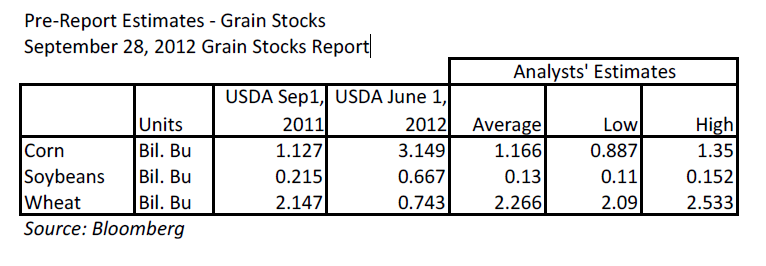 För spannmål och övriga jordbruksprodukter hänvisas till gårdagens nyhetsbrev om jordruksprodukter.
För spannmål och övriga jordbruksprodukter hänvisas till gårdagens nyhetsbrev om jordruksprodukter.
[box]SEB Veckobrev Veckans råvarukommentar är producerat av SEB Merchant Banking och publiceras i samarbete och med tillstånd på Råvarumarknaden.se[/box]
Disclaimer
The information in this document has been compiled by SEB Merchant Banking, a division within Skandinaviska Enskilda Banken AB (publ) (“SEB”).
Opinions contained in this report represent the bank’s present opinion only and are subject to change without notice. All information contained in this report has been compiled in good faith from sources believed to be reliable. However, no representation or warranty, expressed or implied, is made with respect to the completeness or accuracy of its contents and the information is not to be relied upon as authoritative. Anyone considering taking actions based upon the content of this document is urged to base his or her investment decisions upon such investigations as he or she deems necessary. This document is being provided as information only, and no specific actions are being solicited as a result of it; to the extent permitted by law, no liability whatsoever is accepted for any direct or consequential loss arising from use of this document or its contents.
About SEB
SEB is a public company incorporated in Stockholm, Sweden, with limited liability. It is a participant at major Nordic and other European Regulated Markets and Multilateral Trading Facilities (as well as some non-European equivalent markets) for trading in financial instruments, such as markets operated by NASDAQ OMX, NYSE Euronext, London Stock Exchange, Deutsche Börse, Swiss Exchanges, Turquoise and Chi-X. SEB is authorized and regulated by Finansinspektionen in Sweden; it is authorized and subject to limited regulation by the Financial Services Authority for the conduct of designated investment business in the UK, and is subject to the provisions of relevant regulators in all other jurisdictions where SEB conducts operations. SEB Merchant Banking. All rights reserved.
Analys
Sell the rally. Trump has become predictable in his unpredictability

Hesitant today. Brent jumped to an intraday high of $66.36/b yesterday after having touched an intraday low of $60.07/b on Monday as Indian and Chinese buyers cancelled some Russian oil purchases and instead redirected their purchases towards the Middle East due to the news US sanctions. Brent is falling back 0.4% this morning to $65.8/b.

It’s our strong view that the only sensible thing is to sell this rally. In all Trump’s unpredictability he has become increasingly predictable. Again and again he has rumbled about how he is going to be tough on Putin. Punish Putin if he won’t agree to peace in Ukraine. Recent rumbling was about the Tomahawk rockets which Trump threatened on 10 October and 12 October to sell/send to Ukraine. Then on 17 October he said that ”the U.S. didn’t want to give away weapons (Tomahawks) it needs”.
All of Trump’s threats towards Putin have been hot air. So far Trump’s threats have been all hot air and threats which later have evaporated after ”great talks with Putin”. After all these repetitions it is very hard to believe that this time will be any different. The new sanctions won’t take effect before 21. November. Trump has already said that: ”he was hoping that these new sanctions would be very short-lived in any case”. Come 21. November these new sanctions will either evaporate like all the other threats Trump has thrown at Putin before fading them. Or the sanctions will be postponed by another 4 weeks or 8 weeks with the appearance that Trump is even more angry with Putin. But so far Trump has done nothing that hurt Putin/Russia. We can’t imagine that this will be different. The only way forward in our view for a propre lasting peace in Ukraine is to turn Ukraine into defensive porcupine equipped with a stinging tail if need be.
China will likely stand up to Trump if new sanctions really materialize on 21 Nov. Just one country has really stood up to Trump in his tariff trade war this year: China. China has come of age and strength. I will no longer be bullied. Trump upped tariffs. China responded in kind. Trump cut China off from high-end computer chips. China put on the breaks on rare earth metals. China won’t be bullied any more and it has the power to stand up. Some Chinese state-owned companies like Sinopec have cancelled some of their Russian purchases. But China’s Foreign Ministry spokesperson Guo Jiakun has stated that China “oppose unilateral sanctions which lack a basis in international law and authorization of the UN Security Council”. Thus no one, not even the US shall unilaterally dictate China from whom they can buy oil or not. This is yet another opportunity for China to show its new strength and stand up to Trump in a show of force. Exactly how China choses to play this remains to be seen. But China won’t be bullied by over something as important as its oil purchases. So best guess here is that China will defy Trump on this. But probably China won’t need to make a bid deal over this. Firstly because these new sanctions will either evaporate as all the other threats or be postponed once we get to 21 November. Secondly because the sanctions are explicit towards US persons and companies but only ”may” be enforced versus non-US entities.
Sanctions is not a reduction in global supply of oil. Just some added layer of friction. Anyhow, the new sanctions won’t reduce the supply of Russian crude oil to the market. It will only increase the friction in the market with yet more need for the shadow fleet and ship to ship transfer of Russian oil to dodge the sanctions. If they materialize at all.
The jump in crude oil prices is probably due to redirections of crude purchases to the Mid-East and not because all speculators are now turned bullish. Has oil rallied because all speculators now suddenly have turned bullish? We don’t think so. Brent crude has probably jumped because some Indian and Chinese oil purchasers of have redirected their purchases from Russia towards the Mid-East just in case the sanctions really materializes on 21 November.
Analys
Brent crude set to dip its feet into the high $50ies/b this week

Parts of the Brent crude curve dipping into the high $50ies/b. Brent crude fell 2.3% over the week to Friday. It closed the week at $61.29/b, a slight gain on the day, but also traded to a low of $60.14/b that same day and just barely avoided trading into the $50ies/b. This morning it is risk-on in equities which seems to help industrial metals a little higher. But no such luck for oil. It is down 0.8% at $60.8/b. This week looks set for Brent crude to dip its feet in the $50ies/b. The Brent 3mth contract actually traded into the high $50ies/b on Friday.

The front-end backwardation has been on a weakening foot and is now about to fully disappear. The lowest point of the crude oil curve has also moved steadily lower and lower and its discount to the 5yr contract is now $6.8/b. A solid contango. The Brent 3mth contract did actually dip into the $50ies/b intraday on Friday when it traded to a low point of $59.93/b.
More weakness to come as lots of oil at sea comes to ports. Mid-East OPEC countries have boosted exports along with lower post summer consumption and higher production. The result is highly visibly in oil at sea which increased by 17 mb to 1,311 mb over the week to Sunday. Up 185 mb since mid-August. On its way to discharge at a port somewhere over the coming month or two.
Don’t forget that the oil market path ahead is all down to OPEC+. Remember that what is playing out in the oil market now is all by design by OPEC+. The group has decided that the unwind of the voluntary cuts is what it wants to do. In a combination of meeting demand from consumers as well as taking back market share. But we need to remember that how this plays out going forward is all at the mercy of what OPEC+ decides to do. It will halt the unwinding at some point. It will revert to cuts instead of unwind at some point.
A few months with Brent at $55/b and 40-50 US shale oil rigs kicked out may be what is needed. We think OPEC+ needs to see the exit of another 40-50 drilling rigs in the US shale oil patches to set US shale oil production on a path to of a 1 mb/d year on year decline Dec-25 to Dec-26. We are not there yet. But a 2-3 months period with Brent crude averaging $55/b would probably do it.
Oil on water increased 17 mb over the week to Sunday while oil in transit increased by 23 mb. So less oil was standing still. More was moving.

Crude oil floating storage (stationary more than 7 days). Down 11 mb over week to Sunday

The lowest point of the Brent crude oil curve versus the 5yr contract. Weakest so far this year.

Crude oil 1mth to 3mth time-spreads. Dubai held out strongly through summer, but then that center of strength fell apart in late September and has been leading weakness in crude curves lower since then.

Analys
Crude oil soon coming to a port near you

Rebounding along with most markets. But concerns over solidity of Gaza peace may also contribute. Brent crude fell 0.8% yesterday to $61.91/b and its lowest close since May this year. This morning it is bouncing up 0.9% to $62.5/b along with a softer USD amid positive sentiment with both equities and industrial metals moving higher. Concerns that the peace in Gaza may be less solid than what one might hope for also yields some support to Brent. Bets on tech stocks are rebounding, defying fears of trade war. Money moving back into markets. Gold continues upwards its strong trend and a softer dollar helps it higher today as well.

US crude & products probably rose 5.6 mb last week (API) versus a normal seasonal decline of 2.4 mb. The US API last night partial and thus indicative data for US oil inventories. Their data indicates that US crude stocks rose 7.4 mb last week, gasoline stocks rose 3.0 mb while Distillate stocks fell 4.8 mb. Altogether an increase in commercial crude and product stocks of 5.6 mb. Commercial US crude and product stocks normally decline by 2.4 mb this time of year. So seasonally adjusted the US inventories rose 8 mb last week according to the indicative numbers by the API. That is a lot. Also, the counter seasonal trend of rising stocks versus normally declining stocks this time of year looks on a solid pace of continuation. If the API is correct then total US crude and product stocks would stand 41 mb higher than one year ago and 6 mb higher than the 2015-19 average. And if we combine this with our knowledge of a sharp increase in production and exports by OPEC(+) and a large increase in oil at sea, then the current trend in US oil inventories looks set to continue. So higher stocks and lower crude oil prices until OPEC(+) switch to cuts. Actual US oil inventory data today at 18:00 CET.
US commercial crude and product stocks rising to 1293 mb in week 41 if last nights indicative numbers from API are correct.

Crude oil soon coming to a port near you. OPEC has lifted production sharply higher this autumn. At the same time demand for oil in the Middle-East has fallen as we have moved out of summer heat and crude oil burn for power for air-conditioning. The Middle-East oil producers have thus been able to lift exports higher on both accounts. Crude oil and condensates on water has shot up by 177 mb since mid-August. This oil is now on its way to ports around the world. And when they arrive, it will likely help to lift stocks onshore higher. That is probably when we will lose the last bit of front-end backwardation the the crude oil curves. That will help to drive the front-month Brent crude oil price down to the $60/b line and revisit the high $50ies/b. Then the eyes will be all back on OPEC+ when they meet in early November and then again in early December.
Crude oil and condensates at sea have moved straight up by 177 mb since mid-August as OPEC(+) has produced more, consumed less and exported more.

-

 Nyheter3 veckor sedan
Nyheter3 veckor sedanGoldman Sachs höjer prognosen för guld, tror priset når 4900 USD
-

 Nyheter4 veckor sedan
Nyheter4 veckor sedanBlykalla och amerikanska Oklo inleder ett samarbete
-

 Nyheter4 veckor sedan
Nyheter4 veckor sedanGuld nära 4000 USD och silver 50 USD, därför kan de fortsätta stiga
-

 Nyheter2 veckor sedan
Nyheter2 veckor sedanLeading Edge Materials är på rätt plats i rätt tid
-

 Nyheter3 veckor sedan
Nyheter3 veckor sedanNytt prisrekord, guld stiger över 4000 USD
-

 Nyheter4 veckor sedan
Nyheter4 veckor sedanEtt samtal om guld, olja, koppar och stål
-

 Analys4 veckor sedan
Analys4 veckor sedanOPEC+ will likely unwind 500 kb/d of voluntary quotas in October. But a full unwind of 1.5 mb/d in one go could be in the cards
-

 Nyheter4 veckor sedan
Nyheter4 veckor sedanNeptune Energy bekräftar enorma litiumfyndigheter i Tyskland




